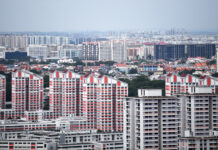SINGAPORE: Leadership renewal continues apace but the management of the health and economic crisis arising from the coronavirus pandemic is top priority.
This is the message of Prime Minister Lee Hsien Loong’s Cabinet line-up announced 15 days after Singapore’s most recent general election.
Younger and newer leaders must take this time to prove their mettle not just to their ministerial mentors but also to a Singapore public that has now been exposed to robust debates, fair, accurate or otherwise, led by the opposition parties during the campaigning period on how the country has dealt with the severe impact of the pandemic.
BOLSTERING THE HEALTH AND MANPOWER MINISTRIES
Mr Lee said he has kept status quo in ministries and the multi-ministry taskforce directly involved in addressing this “the crisis of a generation” – something he would have done irrespective of opposition charges during the election.
He has also boosted the capacity of these to develop better policies and programmes on the ground. These moves also address important perception gaps the emerged in the hustings.
Two medical practitioners Dr Koh Poh Koon and Dr Janil Puthucheary have been introduced into the team at the Ministry of Health (replacing the one, Dr Lam Pin Min, in the previous Cabinet), and another, Dr Tan See Leng, into the team at the Ministry of Manpower.
LISTEN: GE2020: What it means for the PAP, the opposition and Singapore politic
READ: Commentary: How the Workers’ Party won big this General Election
Bear in mind that this is a Cabinet comprising six doctors before the general election and now five, post-election. They are complemented by the medical specialists in the public health system led by the Director of Medical Services, Associate Professor Kenneth Mak at MOH.
When Mr Lee explained his rationale for rotating the junior ministers, he said he expected Cabinet colleagues to be able to bring in their perspectives and expertise on issues, reinforcing a point he had made on numerous occasions before that the Cabinet plays as a team, with all past and professional experience individual members have, brought to bear in decision-making.
Prime Minister Lee Hsien Loong announcing Singapore’s new Cabinet on Jul 25, 2020.
It will be up to the multi-ministry taskforce, strengthened with political office holders with healthcare expertise in the ministries directly involved in it, to demonstrate that the Singapore response is a well-considered one with the best prevailing medical advice and competing national demands especially of preserving livelihoods balanced.
Although allegations from the opposition Singapore Democratic Party that government decisions on COVID-19, especially the falsehood that MOM had discouraged employers from testing, lacked medical input have been refuted with an official correction, such charges could chip away at public trust in the Government.
With a grasp of the implications of these new Cabinet moves, it will be difficult to argue that medical expertise and the Hippocratic ethos have been left out of the Government’s approach to the crisis.
THE NEED FOR STRONGER COMMUNICATIONS AND OUTREACH
This speaks to a second and perhaps even more critical aspect to the management of the crisis than continuity – that of communications and connection between the Government and the public.
This Cabinet will have to address arguments that the fourth generation (4G) leaders had mishandled the COVID-19 crisis and had put political considerations and desire to showcase their abilities ahead of scientific and healthcare considerations.
READ: Commentary: The sandwiched generation, with kids and seniors, is staying home most days too in Phase 2
READ: Commentary: Older workers vulnerable to rising tide of retrenchment as ageist mindsets persist
In that regard, the three new recruits into Cabinet with background in communications may be an asset if they can indeed work together to that end and help explain how Government functions especially during these difficult times.
Mr Tan Kiat How, former head of IMDA, will head up the government feedback unit called Reach while former Facebook and LinkedIn executive Alvin Tan and former SGSecure Programme Office head Eric Chua will be in the Ministry of Culture, Community and Youth that facilitates citizen engagement with young Singaporeans.
They should lend themselves to efforts at the Ministry of Communications and Information, which has another medical practitioner, Dr Janil Puthucheary as Senior Minister of State there, to set out evidence that the evolving scientific knowledge as well as public health considerations have been critical in shaping a sustainable response to the pandemic.
New Members of Parliament-elect (from left) Gan Siow Huang, Alvin Tan, Desmond Tan and Tan Kiat How will be appointed Ministers of State. (Photos: People’s Action Party)
Revealing in ways possible how the Government makes its decisions not just at the operational and tactical levels but also at the strategic level, and from the National Centre for Infectious Diseases and hospitals managing the outbreak right up to Cabinet, will reinforce the level of trust the public has in its management of the policy issues it entails.
In this, the Government can afford to give greater insight into how recent decisions were arrived at to pre-empt concerns.
For example, is it possible to provide indication of the types of policy negotiations that has transpired between Singapore with other countries and multilateral organisations to moderate the international community’s current “high risk” assessment of Singapore, and how bilateral negotiations in facilitating green channels and cross-border travel are being conducted?
This was another theme in the opposition Progress Singapore Party’s (PSP) criticism of the Government’s management of infections in foreign worker dormitories – that its negligence of one area of risk, namely foreign worker infections, has meant Singapore has had to suffer universal travel bans and their economic ramifications.
LISTEN: Singapore’s relationship with migrant workers: It’s complicated?
READ: Commentary: The systematic testing Singapore needs to ditch circuit breakers for good
It is stunning to realise after all that while the absolute number of infections in Singapore just breached the 50,000 number on Sunday (Jul 26), infections among the non-foreign worker population actually stands at a fraction.
More importantly, the fact that all foreign workers are being tested, treated and segmented to keep well must make a difference in local as well as international perceptions of the Singapore response.
Again, the re-opening of the border with Malaysia has just been agreed upon but there is certainly much to explain and understand about how the management of risk, considerations of business continuity, sustaining livelihoods as well as the goodwill on both sides of the Causeway have contributed to this breakthrough.
NO CHANGE IN LEADERSHIP TRANSITION
Aside from the strengthening of the Government’s policy orientation and engagement efforts, this new Cabinet line-up also sends a strong signal of continuity in the leadership transition journey.
It was notable that there remains one Deputy Prime Minister, the Minister of Finance, Heng Swee Keat.
Deputy Prime Minister Heng Swee Keat speaking at a press conference announcing Singapore’s new Cabinet on Jul 25, 2020.
If the electoral support he garnered as the anchor minister in East Coast Group Representation Constituency (GRC) mattered, some have speculated the 53.41 per cent of the votes his team polled might have wounded him politically. Others have said he “rescued” East Coast from falling to the competing Workers’ Party.
However, because he is still featured as the only DPM, this signals that he is still the one person to succeed Mr Lee as was the case before the election, even if the handover is likely to be delayed until the pandemic is neutralised.
The day after the announcement of the Cabinet line-up, Minister for Foreign Affairs, Dr Vivian Balakrishnan, who is the same vintage and considered within the same leadership cohort as DPM Heng, said there was complete and absolute unity behind DPM’s Heng’s leadership among 4G leaders, laying to rest a re-opening of that question of succession at the very top.
GREATER DIVERSITY, MORE FOCUS ON GROOMING ANCHORS FOR CONSTITUENCIES IN THE EAST
This Cabinet has also showcased greater diversity in Singapore’s national leadership, with nine women, or about a quarter of the 37 positions, five Malays where two are full ministers, and six Indians, five of whom are full ministers. Of the 13 new PAP MPs from the private sector, two have been brought into Cabinet – Dr Tan and Mr Alvin Tan.
READ: Singapore to see record number of women enter Parliament after GE2020
READ: Commentary: Burden of caring for ageing parents weighs heaviest on unmarried daughters
The final feature is this: Several GRCs in the East – East Coast, Marine Parade and Pasir Ris Punggol – now see up to three office-holders in the team. The Workers’ Party has contested in the first two seriously so these shifts shore up the PAP position there.
The pace of leadership development seems slower in other parts of Singapore aside from the East. There are just two members of Cabinet in the Jurong GRC, Chua Chu Kang GRC, Marsiling-Yew Tee and Nee Soon GRC.
But there is time, with more reshuffles ahead to promote good performers in the junior ranks in those parts of the island, bearing in mind that the opposition parties in both the East and West, and certainly, the PSP in the latter, are not standing still either in this dynamic, interactive quest of securing political dominance.
The next development to watch then is the PAP’s election of its Central Executive Committee due at the end of the year.
Dr Gillian Koh is Deputy Director (Research) and Senior Research Fellow in the Governance and Economy Department at the Institute of Policy Studies, National University of Singapore.




